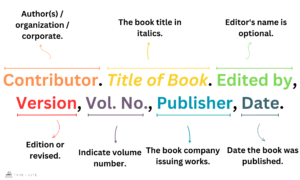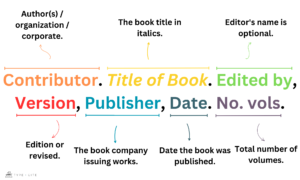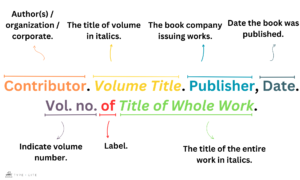How to Cite Multivolume Works in MLA
- Hannah Berry (Ph.D.)
- Published on 02/28/2024
When it comes to citing a volume from a multivolume work in MLA format, there are several methods to follow. Each method serves to indicate the specific volume’s place within the larger work. Here’s a breakdown of how to cite multivolume works in the MLA style:
- Standalone Title: If the volume you’re citing has its own distinct title and the other volumes are not relevant to your discussion, you can simply cite the title of that volume as if it were a standalone work.
- Indicating Volume Number: If you want to signify that the book is part of a larger collection but the overall work is not significant to your discussion, you can simply mention the volume number of the book.
- Full Reference: Alternatively, you may choose to provide a complete reference that includes information about the entire collection of works. This method treats the larger work as a second container.
- Formatting Conventions: It’s important to note the formatting conventions when citing volume numbers. If the volume number comes after the title (and therefore follows a full stop), “Vol.” should be capitalized. However, if the volume number follows additional information such as an edition (and therefore follows a comma), “vol.” should be lowercase.
- Optional Fields: Including fields such as “Edited by” and the editor’s name is optional but may be necessary depending on your citation requirements.
 |
Clarify Editions or Revisions: If the multivolume work has multiple editions or revisions, specify the edition or revised in your citation. This ensures that readers can identify which version of the work you are referencing and allows for accurate tracking of changes or updates across different editions. Include Access Information for Digital Sources: If you are citing a multivolume work sourced from an online database or digital repository, include access information such as DOI (Digital Object Identifier) in your citation. This enables readers to easily locate the referenced material online, facilitating access to the source material for further examination or verification. Narrative Citation: The first time you mention an author’s name in your writing, like “Charles Dickens,” use their full name. After that, just use their last name, such as “Dickens,” for any later references. This keeps your citations clear and easy to follow. Formatting Guidelines: When citing titles in MLA format, use title case, capitalizing the first letter of each major word. Follow MLA abbreviations, such as “University” as “U” and “Press” as “P”, for consistency and adherence to formatting guidelines. |
CITE ONE VOLUME OF A MULTIVOLUME WORK
In this citation format, the inclusion of any specific edition or version of the book, if applicable, precedes the mention of the volume number within the multivolume set. This sequence is important as it ensures that readers are informed about any variations or updates in different editions or versions before understanding the specific volume being cited within the larger multivolume work.
| Citation |
Tailor, Josh. The Renaissance: Art and Culture. Vol. 2, Renaissance Publishing House, 2005. |
| Structure |
Author Surname, Author First Name. Title of Book. Vol. No, Publisher, Publication Date.
|
IN-TEXT CITATIONS
In the narrative citation format for one volume of a multivolume work, begin with the author’s first name(s) and/or initials, followed by their surname. Then, in parentheses, include the page number(s) being referenced from that volume.
| Narrative |
Josh Tailor (45-47)
|
| Structure |
Author First Name Author Surname (Page No(s).)
|
In the parenthetical citation format, start with the author’s surname, followed by the abbreviation “Pg.” for page(s), then the specific page number(s) being referenced.
| Parenthetical |
(Tailor Pg. 45-47)
|
| Structure |
(Author Surname Pg. No(s).)
|
CITE MORE THAN ONE VOLUME OF A MULTIVOLUME WORK
Towards the end of the citation, add the total number of volumes included in the multivolume set.
| Citation |
Parker, Emily. The American Revolution: An Anthology. Edited by Samuel Bennett, Liberty P, 1995-99. 15 vols.
|
| Structure |
Author Surname, Author First Name. Title of Book. Edited by Editor First Name Editor Surname, Publisher, Publication Date(s). No. vols.
|
IN-TEXT CITATIONS
In the narrative citation structure for more than one volume of a multivolume work, the citation begins with the author’s first name and/or initials followed by their surname, followed by the specific volume number indicated by “Vol.”, a colon, and then the relevant page number(s), providing a comprehensive indication of the author, volume, and page range referenced within the text.
| Narrative |
Emily Parker (2: 18)
|
| Structure |
Author First Name Author Surname (Volume Number: Page Number)
|
In the parenthetical citation format, the author’s surname is followed by the abbreviated term “Vol.” denoting volume, then the volume number, a colon, and finally the page number(s), offering a concise yet informative reference within parentheses.
| Parenthetical |
(Parker 2: 18)
|
| Structure |
(Author Surname Volume Number: Page Number)
|
CITE ONE VOLUME OF A MULTIVOLUME WORK WITH ITS OWN TITLE
When a specific volume within a multivolume work contains its own distinct title, according to MLA 9 guidelines, it is recommended to provide the title of the entire work as an additional supplementary element.
| Citation |
Caro, Robert. The Passage of Power. Vintage Books, 2012. Vol. 4 of The Years of Lyndon Johnson.
|
| Structure |
Author Surname, Author First Name. Title of Volume. Publisher, Publication Date. Vol. no of Title of Whole Work.
|
Note: The narrative and parenthetical citation follows the same format as one volume of a multivolume work.
GIVE YOUR CITATIONS A BOOST TODAY
Start your TypeCite Boost 3 day free trial today. Then just $4.99 per month to save your citations, organize in projects, and much more.
SIGN UP

